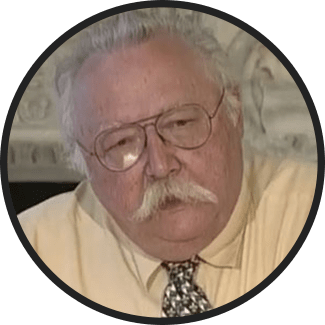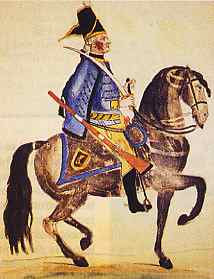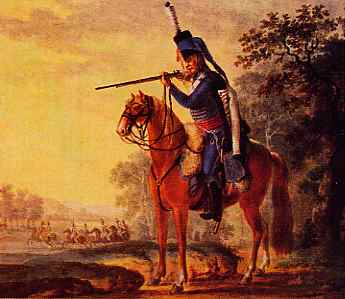Contents
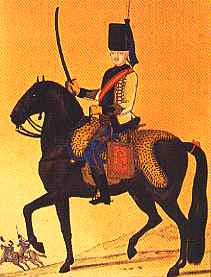
Contents
They were the Volontaires-etrangers de Lauzun, the light troops of the little army France sent across the Atlantic in 1780 that tipped the scales in favor of American independence. Even by 18th-century standards, this underpaid outfit of foreign volunteers was unconventional, to say nothing of undisciplined. Almost one thousand strong before disbanding, they accounted for about a sixth of the French forces, but caused about two-thirds of the troubles of Lieutenant General Jean Baptiste Donatien de Vimeur, Comte de Rochambeau, commanding officer of the expedition. They were led, however, by a man Rochambeau said performed during the Yorktown campaign with more distinction than every French superior officer but one.
The rank and file included subjects of 15 European countries, from Ireland to Russia and from Denmark to Hungary. Just a third of the men were French. Fifty-five percent came from Alsace, Lorraine, and the myriad states of the Holy Roman Empire of German Nation. The officers hailed from Sweden and from France, from England and Ireland, from Poland and from sundry German states. Among them they spoke eight tongues, but by tradition and heritage the unit cursed in Hungarian. They were part of the French armed forces, yet by ordonnance of the Ministere de la Marine their language of command was German. They were light infantry and cavalry, but took their orders from the naval minister.
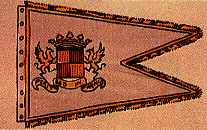
Formed March 5, 1780, Lauzun’s Legion, as it commonly was called, existed little more than three years before it was disbanded. Its foes, and some of its friends, might have agreed with a conclusion the London Chronicle had reached near the end of France’s Seven Years’ War with England: a legion had to derive its name from “the legion of devils mentioned in the Bible.”
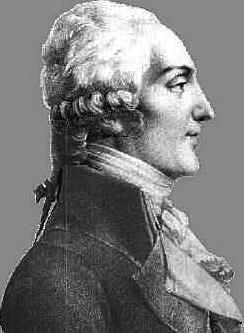
Lauzun’s Legion derived its name from its colonel-proprietaire, inspecteur and commanding officer Armand Louis de Gontaut, Duc de Lauzun – pronounced, approximately, Lou-zun. Born in Paris on April 13, 1747, into a family titled since the 12th century, Lauzun personified the values, faults, and ideals of the French nobility at the end of the ancien regime. Three months before his 14th birthday, he became an ensign in the elite French Guards, commanded by his uncle the Duc de Biron. He was not quite 19 when he married Amelie de Boufflers, the 14-year-old daughter of Charles Joseph Duc de Boufflers, in February 1766. They lived apart and he had no legitimate children. Six months after Lauzun turned 20, he was breveted a colonel. In 1769, he fought in recently annexed Corsica without orders or authorization, though his reckless courage brought him the colonelcy of the Legion Royale in February 1774.
The general peace that prevailed in Europe left Lauzun yearning for opportunities to add the honors of war to the laurels he earned in the bedrooms of Versailles. His moment arrived in April 1775 when the shots at Lexington and Concord called France’s attention to an opportunity to revenge herself on Great Britain for the humiliating Treaty of Paris, the pact that concluded the Seven Years’ War – what Americans call the French and Indian War – in 1763.
France aided the American rebels cautiously and clandestinely until their victory at Saratoga in October 1777 persuaded His Most Christian Majesty, King Louis XVI of France, that the revolution might succeed. On February 6, 1778, he signed treaties of Amity and Friendship, and of Military Alliance with the United States, becoming the first ruler to recognize the new nation. On March 13, Versailles officially informed the Court of St. James’s of the agreements, which all sides understood as a declaration of war. King George III promptly recalled the English ambassador to France. British ships attacked the French frigate Belle Poule off Normandy in early June, and Louis XVI responded July 10 by ordering his navy to give chase to Royal Navy vessels. Lauzun had his war.
France, however, was not quite ready to fight. Its fleet, for example, was short of marines. A 110-gun man-of-war required 260 infantry men and four officers to supplement its crew. A 16-gun corvette needed 15 soldiers. On September 1, 1778, the naval minister, the Comte de Sartine, ordered creation of the Volontaires-etrangers de la Marine: eight legions of about 70 officers and four companies of infantry, one of artillery, one of workmen and two escadrons of hussars each. A compagnie generale of seven officers, 13 non-commissioned officers, two trumpeters, a farrier, a chirurgien-aide-major, or medic, and 88 hussars – light, irregular cavalry – brought the strength of the volontaires, or volunteers, to almost 600 officers and 4,500 men. Raised among mostly German-speaking etrangers, or foreigners, often with checkered service records, the volunteers suplemented the number of French marines.
Lauzun volunteered his services as soon as war was declared. On August 16, 1778, he was given permission to raise two companies of lancers and two of hussars. On September 1, he became colonel proprietaire des volontaires-etrangers de la Marine; and his commands were integrated into the unit.
He did not wait idly for his men to be recruited, equipped, and trained, however. In January 1779, he led the military force that conquered Senegal. Come April, Lauzun was back in France and spent the summer and fall of 1779 in Brittany with the Second Legion of his volunteers ready for an attack on England. Commanded by Lauzun, the legion’s 32 officers, 523 light infantry and 156 hussars – the muster roll in June 1779 – were the vanguard of 200 officers and 3,300 men of the first wave of assault scheduled to cross the Channel under Rochambeau’s command. But the invasion was scrubbed.
In its place, Louis XVI approved plans February 2, 1780, for an expedition particulare, the ferrying of ground forces to America. In early February, Versailles put in charge of naval forces the Chevalier de Ternay a chef d’escadre, or commodore, with 40 years of experience. Promoted to lieutenant general March 1, Rochambeau, a professional soldier for 37 years, had charge of the army.
Ternay was to find shipping for six regiments of infantry, 6,000 men, but could locate berths only for 5,300. Rochambeau lobbied in Versailles to have this force increased and succeeded in adding the 2nd Battalion of the Auxonne Artillery, 500 men, and a few dozen engineers. Since he wanted light troops as well, two regiments of infantry had to be cut from the roster. Lauzun, eager to participate in the American campaign, was, in his own words, “too much in fashion not to be employed in some brilliant manner.” He later said Rochambeau “asked for myself, and was refused; he insisted, and they agreed; but this was not decided until the day upon which he took leave of the King.” This may be true, but Lauzun lobbied hard, too. It is hardly coincidental that March 1, the day Rochambeau received his orders from the king, Lauzun was promoted to brigadier general and appointed to command the light troops.
Most of Lauzun’s volontaires-etrangers de la marine were already employed. The First Legion had been raised in the West Indies and participated in the capture of Grenada in July 1779. The Third Legion was stationed on the the Ile de France – today’s Mauritius – in the Indian Ocean for deployment in India. But the Second Legion, quartered on the coast of Brittany, was available. On March 5, 1780, recruitment for the remaining five legions of the foreign volunteers was suspended. Surplus staff, the compagnie generale, its headquarters hussars, the Second Legion, and four infantry companies of the Volontaires-etrangers de Nassau, attached to the Second Legion since June 1, 1779, were suppressed.
Of these units, the order of March 5 created the Volontaires etrangers de Lauzun. Its infantry component was five companies: two of fusiliers, or common soldiers, and one chasseurs, or light infantry, of six officers, 18 non-commissioned officers, a priest, two tambours “ou autres Instrumens,” of 144 men each, and a grenadier company of six officers and 102 non-commissioned officers and men. The cannonier company was to have six officers and 165 men for its four 4-pounders, and the two escadrons of hussars, or squadrons of horse, with six officers and 168 men each. A staff of five officers, 14 non-coms, and a provost completed the unit. Its nominal strength was 1,196 officers and men. With a regimental-size unit created for him to use across the ocean, Lauzun was set to sail.
He, his staff, and most of his men boarded the Provence, a 64-gun ship, on April 5. The remainder of the Legion embarked on the transport Baron D’Arras, and 60 men made the crossing on the Lyon. Because of a lack of shipping, only 600 hussars, grenadiers, chasseurs, and cannoniers made the crossing; another 400 had to be left along with the hussars’ horses. Each animal required the space of ten men, and the 170 animals of just one eseadron would have used 55,000 gallons of water in the transatlantic journey.
Almost left behind was colonel-en-second Robert Dillon, Lauzun’s second-in-command. Dillon had disembarked Sunday, April 16, to mail letters. Four days later, he returned bleeding from two saber wounds sustained in a duel with a gendarme. It was neither the first, nor the last, of this Franco-Irish hothead’s duels, but Lauzun asked no questions about this affaire d’honneur, and neither did Rochambeau, who merely confined Dillon to his quarters.
When Rochambeau boarded the Duc de Bourgogne on April 17, everything was ready. The fleet waited in the rain for the wind to change. The first attempt to clear the coast failed, but Ternay’s convoy of 32 transports protected by seven ships of the line, two frigates, and two smaller warships left Brest on May 2 with 12,000 soldiers and sailors.

The men of Lauzun’s Legion costumed themselves in European finery that sharply contrasted with the makeshift uniforms of their American allies.
The convoy sailed into Narragansett Bay on July 11, 1780. As soon as horses could be found for them, Lauzun’s troopers were deployed around Brenton Point, southwest of Newport, Rhode Island. This separation from the main body of the army was the first in a pattern the Legion developed during the American campaign. The Legion’s winter quarters were in Lebanon, Connecticut, instead of Rhode Island; in 1781, it would march separately to White Plains; at Yorktown it was deployed north of the York River at Gloucester instead of on the primary battlefield. Its Virginia quarters in the winter of 1781 were in Hampton and Charlotte Courthouse, instead of Yorktown and Williamsburg, and when Rochambeau’s infantry sailed for the Caribbean in December 1782, Lauzun’s legion remained behind in Wilmington, Delaware.
Patterns of misconduct established themselves as well. On September 6, 1780, Dillon, his wounds healed, fought a duel with the Vicomte de Noailles, colonel-en-second of the Soissonnais infantry, the Marquis de Lafayette’s brother-in-law.
Lieutenant-Colonel Claude Etienne Hugau wrote the only known firsthand account of the Legion in America, Details interessants sur les evenements arrives dans la guerre d’Amerique, or, roughly, Interesting Account of Events that occurred during the War in America. In it, he said 20 percent of the Lauzun Legion’s officers were involved in duels from November 1781 to May 1782 during winter quarters in Virginia.
Despite Rochambeau’s strict orders that the French pay for everything they used, complaints about Lauzun’s officers and men followed the unit. As long as the troops were in winter quarters in Lebanon, Connecticut, or Newport, they were fairly easy to supervise. Once the campaign started in late June 1781 and the hussars roamed more freely, accusations multiplied. In early July, Baron Cromot du Bourg, an aide-de-camp to Rochambeau, wrote that the Legion had “pillaged many houses.” He seems to have expected such behavior from the hussars, but this time, he said, “even the grenadiers and chasseurs had a hand in it.”
Many of Lauzun’s men liked America well enough to want to stay for good, even without leave. It is here that the multi-national character of the Legion, the dubious background of its personnel, and its ethnic composition showed itself. Germans were more likely to desert in America than Frenchmen: of 316 deserters of Rochambeau’s corps who avoided recapture, 104 were Germans or German-speaking soldiers of the German Royal Deux-Ponts. Another 186 were German-speaking soldiers mostly from Lorraine or Alsace in Rochambeau’s other units. Of those, 132 belonged to Lauzun’s Legion, which gave the unit a desertion rate of about 13 percent, more than twice the 5 percent composite rate.
As early as December 1780, a complete patrol of hussars, horses and all, took off into the forests of Connecticut from their winter quarters in Lebanon, and before the campaign of 1781 began in June, more than two dozen had granted themselves discharges. Thirty-seven more deserted in Virginia in the summer of 1782, and just before departure for France, another wave of desertions hit the Legion.
The first two Frenchmen to die for desertion were the corporals Christoph Hand and Joseph Frank, executed by firing squad in Lebanon in April 1781. The only other deserter from Lauzun’s Legion to be recaptured was sentenced to 16 years in the galleys.
In defense of the Legion it should be said that three-fourths of the deserters in the fall of 1780 had once before deserted from Britain’s German allies and had been recruited only after Lauzun’s arrival in America. In late December 1780, Rochambeau ordered Lauzun to bother no longer with Hessian turncoats.
Many officers gave their men plenty of reasons to desert. In the 18th century, few self-respecting officers in any European army with a regular commission in a line regiment would have volunteered for service in irregular light troops, whether they were called volunteers, as in England, Freikorps, as in Germany, or legion, as in France. Such units often attracted dishonorably dismissed officers, adventurers, and cutthroats who made the lives of their subordinates miserable.
Raised usually only for the duration of a conflict, volunteers were considered expendable in battle – cannon fodder, as Frederick the Great called them. Even by French army standards these men were poorly paid: A grenadier in Rochambeau’s regular units received 198 livres per year before stoppages – deductions for food, uniforms, horses, and so on. A grenadier in Lauzun’s Legion had 66 livres, one third the pay of a line regiment. So it went for all ranks from fusiliers and chasseurs, 171 livres to 57 livres, to the colonel-commandant, where the difference was 13,200 livres to 6,000 livres.
Officers determined to look after their men and trying to use their commission as a springboard into the regular army, had much with which to contend. Lauzun’s Legion had its share of misfits from Dillon down.
After an otherwise uneventful fall, Lauzun’s forces went into winter quarters November 1, 1780. Because “the immoderate cupidity of the neighboring inhabitants” around Newport, Rochambeau said, “raised forage to an extravagant price in hard money,” the cavalry was quartered in Connecticut. After a brief stay in Windham, Lauzun and 220 to 240 hussars moved themselves to Lebanon.
“Siberia alone can furnish any idea of Lebanon, which consists of a few huts scattered among vast forests,” Lauzun wrote in his memoirs. In January 1781, he used the news of the mutiny of the Pennsylvania and New Jersey lines to return to Newport. His hussars languished in Siberia until early summer, when Washington and Rochambeau decided May 22 at a conference in Wethersfield to make New York City the target for the campaign of 1781. Replacements from the Regiment Barrois, which arrived in Newport in early June, brought the strength of Lauzun’s Legion back up to just over 600 men.
They left Lebanon on June 21 and reached White Plains, New York, in early July, But the proposed siege of New York City was too much even for the combined Franco-American army. News of the departure of Admiral de Grasse’s fleet for the Chesapeake Bay caused a change in plans. On August 18, the armies began a march for Virginia. By August 30, the legionnaires were resting at Somerset Court House, and by September 8 they had reached Head of Elk, Maryland.
Here Lauzun and his infantry, 270 men, embarked on boats for the journey down the Chesapeake. The hussars under Vicomte Rene Marie de Darrot, 250 men strong, forded the Susquehanna River at Bald Friar’s Ferry, and advanced south by Baltimore, Georgetown, and Fredericksburg. They crossed the Rappahannock River two miles above Falmouth, and rode on to Williamsburg. There the hussars received orders to reenforce the 1,200 or so militia under Brigadier General George Weedon encamped at Gloucester Courthouse on the north side of the York, where they arrived on the 24th.
Lauzun said in his memoirs that on the previous day a distressed Washington had informed him that “Lord Cornwallis had sent all his cavalry and a considerable body of troops to Gloucester, opposite York,” where they were “watched by a corps of three thousand militiamen under the continental Brigadier-General Weedon.” Lauzun considered Weedon, his senior, “a good enough soldier, but one who hated war, in which he had never wished to engage, and went in deadly fear of coming under fire.”
The commander-in-chief suggested, Lauzun said, that he would tell Weedon that Weedon could have “all the honours” of war but forbid him “to interfere in any way” with Lauzun. Lauzun rejected the arrangement. Once his infantry had disembarked ahead of Rochambeau’s main army near Jamestown on the 23rd, Lauzun set out for Gloucester, where he joined his cavalry on the 28th.
He was determined on “getting on excellently” with his American counterpart. Lauzun could be charming. Rochambeau once described him privately as the “most amiable man in France.” But he also thought that Lauzun was “often the most foolish…who never had enough force of character to be successful.” Weedon, an innkeeper from Fredericksburg who had seen battle more than once, may have been “the best fellow in the world,” whose “one desire was not to interfere in anything.” But he had his pride and saw no reason to defer to a boisterous French aristocrat. Weedon may have been afraid of the British, but he was not afraid of Lauzun.
In one of their first exchanges of dispatches, the American informed his French ally of pillage by hussars around West Point and demanded Lauzun put an end to such misdeeds. Apparently worse had happened along the route: On October 1, Jacques Bergeot, a 25-year-old chasseur of the Lauzun’s Legion, was executed “for … homicide.”
On the 29th, Rochambeau sent Brigadier General Claude Gabriel de Choisy, who had just arrived with the siege artillery from Newport, to Gloucester. With him went 100 men each from eight regiments embarked on Admiral de Grasse’s fleet. The 58-year-old Choisy, who outranked Weedon, was, according to Lauzun, “a good and gallant man, ridiculously violent, constantly in a rage, always making scenes with everyone, and entirely devoid of common sense.” Choisy arrived at Gloucester on October 1 and “began by finding fault with General Weedon and all the militia and told him that they were cowards.”
Choisy had a little more than 2,500 men under his command. But in a letter to Rochambeau of October 2, de Grasse had informed Rochambeau that the men he had sent “are without shoes &&&. Please feed them; I have made the same request to M. le duc de Lauzun.” The “&&&” meant, Choisy said to Rochambeau a few days later, that “the men have neither tents, nor kettles, nor mess tins.”
They and their leaders also lacked combat experience. Only Lauzun’s men had been in battle before, at Morrisania, New York, and in skirmishes along the way to Virginia. On October 3, they showed that they could not only drink, duel, and steal like the rest of them, but fight with the best of them. These French were not, as Colonel Fontaine of the Virginia militia said he had been led to believe, “people living on frogs and coarse vegetables.”
Cornwallis had fortified Gloucester, a hamlet of four houses opposite Yorktown, with entrenchments, four strong redoubts and three batteries with 19 pieces altogether, mostly 18-pounders. British Lieutenant Colonel Thomas Dundas’s garrison numbered about 1,100 men, almost half of them cavalry. Dundas’s contingent was almost as diverse as Lauzun’s. It included Scotsmen from Dundas’s 80th Regiment, the Royal Edinburgh Volunteers, and men of the 23rd Regiment, the Royal Welsh Fusiliers. Also at Gloucester were the Germans of the Hessian Regiment Erbprinz, and American Loyalists in the Queen’s Rangers under Major John Simcoe, and the North Carolina Volunteers under Colonel John Hamilton. Of more interest to Lauzun was the British Legion at Gloucester, about 240 men under the notorious Lieutenant Colonel Banastre Tarleton. Lauzun was anxious to cross swords with Tarleton.
The opportunity. came October 3. Choisy wanted to move closer to Gloucester and set out with Lauzun’s Legion, 250 cavalry and an equal number of infantry, and Lieutenant Colonel John Mercer’s Select Battalion of the Virginia militia. Tarleton was out foraging with 240 horse of the British Legion and about 350 infantry of the 23rd Royal Welsh Fusiliers, 150 of them mounted.
Just as the French forces emerged from a forest three miles from Gloucester into open ground, Virginia dragoons rode “in a great panic” up to Lauzun. They told him “that they had seen some English dragoons in the open, and, for fear of accidents, had ridden away hell for leather, without examining them further.” Scouting ahead, Lauzun met a woman who told him “that, at that very moment, Colonel Tarleton had left her house…most anxious ‘to shake hands with the French duke.’ I assured her that I had come there on purpose to give him that satisfaction.”
Lauzun heard his advance guard fire pistols. He galloped ahead of his cavalry and, once he had spied Tarleton, made directly for him. One of Tarleton’s own men rode him down, and the Englishman was thrown to the ground. But his dragoons rescued him, and Lauzun had to content himself with Tarleton’s horse. Tarleton’s men retreated, returned to the charge, were thrown back again, and broke for the protection of a company of the 23rd.
The Welshmen stopped Lauzun’s infantry, but were in turn checked by Mercer’s militia. British casualties numbered 12 of Tarleton’s men and an infantry officer; the Americans lost 2 killed and 11 wounded, Lauzun lost 3 killed and 16 wounded. Among the wounded was duelist Dillon. But Lauzun’s men were masters of the battlefield. Choisy pushed his advance posts to within a mile of Gloucester, and there they remained.
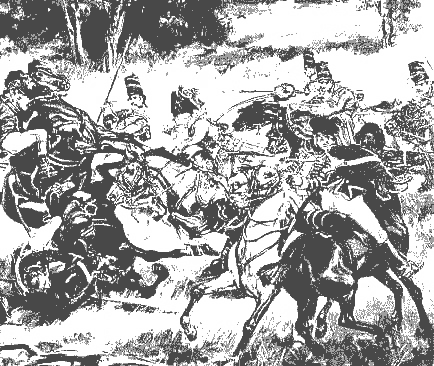
The next time the adversaries met was October 19. At 3:00 p.m., an hour after the garrison at Yorktown surrendered, about 1,100 Englishmen, Scotsmen, Welsh, Germans, and loyalist Americans filed out of Gloucester and grounded their arms in front of “100 of Lauzun’s men and 200 men from the American militia.”
Joachim du Perron, Comte de Revel, a sub-lieutenant in the Monsieur Infantry who had come from the Caribbean with de Grasse, provided one of the rare eyewitness accounts. Perron reported the British “were vexed to deliver” their weapons “to the Americans, for whom they showed great scorn; they called our soldiers and presented them with their guns.”
Tarleton was absent. Afraid for his safety, he had asked Rochambeau’s protection and permission to remain within Gloucester. Though Rochambeau considered Tarleton a butcher and barbarian without merit as an officer, permission was granted.
“After the ceremony,” Perron said, “they went back to their entrenchments and M. de Choisy established guards in all their redoubts. The English officers came to see our officers who were on duty there, showed them every possible courtesy, and drank to their health, while they said not a word to any American officer; several even did what they could to persuade our gentlemen to accept sabers, fowling pieces, carbines etc., adding that they would rather break them into a thousand pieces than leave them to the Americans.” Perron also met Tarleton, “a young man 25 years old,” and found him pleasant. He “had a most gentle and genteel face as well as elegance, a certain air of ease, and French manners.”
Relations between the Yankees and their French allies grew strained. On the 21st, de Grasse’s men handed their “tents, canteens and mess tins to Lauzun’s Legion; their own were in bad shape. At 9 o’clock we decamped, quite pleased to separate from the American militia who were cocky now that they were no longer in fear of the English and had already had some disputes with our soldiers.”
The following day, Lauzun sailed for France with the news of the victory: Rochambeau had selected him as one of “the two superior officers who have performed the two most distinguished feats.” Lauzun’s was the cavalry engagement with Tarleton; the other officer’s was William de Deux Pont’s storming of Redoubt No. 9 before Yorktown the night of October 14.
Three weeks later, Lauzun’s Legion entered winter quarters in Hampton. In early November, a local man charged that hussars had stolen one of his horses. Choisy showed him the Legion’s mounts. The man picked one of the better steeds and claimed it. But that horse had been presented to Lauzun as a gift by Washington and the claim was denied. That does not mean, however, that the man may not have been missing a horse.
When Major Jean Ladislas Pollerescky, a German-born Slovak who was now third-in-command of the Legion, asked for leave November 11 to attend to his affairs in Europe, Lieutenant Colonel Hugau arrested him on 20 charges. Hugau feared that Pollerescky wanted to return to Europe because “there was nothing left for him to glean in this country.” By “glean” he meant steal. Among the more serious allegations against Pollerescky was running a horse-theft ring. Item five of the indictment accused Pollerescky of having stolen a “beautiful table” from a house at Gloucester as well as having stripped a library of its books. Pollerescky had blamed the house thefts on other people.
Professor Samuel F. Scott of Wayne State University in Detroit, an expert on Rochambeau’s forces, discovered that Mary Harris of Gloucester charged in December that French hussars had robbed her of bedding, silverware, food, and kitchen utensils, which she valued at almost £22. Even though she couldn’t identify the culprits, Rochambeau, anxious to keep Franco-American relations smooth, gave her 70 Spanish dollars, about £15 1/2.
Pollerescky produced a letter from Lauzun approving his leave that Hugau thought he could not ignore and the accused left Hampton for Europe on November 13. His outraged fellow officers said they would never again have dealings with him. The ostracized Pollerescky was back in Boston in late 1784. With the help of General Benjamin Lincoln, whom he had befriended before Yorktown, he purchased a farm in Dresden, Maine, in 1785. When General Henry Dearborn, another friend of Yorktown days, became military governor of the District of Maine in 1790, he appointed Pollerescky census commissioner. It was Pollerescky’s first in a long line of civil service positions that included lighthouse keeper on the island of Seguin, and 25 years as town clerk, a position in which he died at age 80 in 1828.
If Virginians had reason to complain, so did the French. In March 1782, Hugau was presented a bill of more than 44,000 livres, almost £1,900, for damages to fodder and grain from the end of September to November 19, 1781. Rochambeau paid the bill though aware it was inflated and that he got shoddy merchandise for his silver. In November, a half dozen of the 151 cattle purchased in Virginia for his troops died of distemper before they could be slaughtered. Eventually, Rochambeau’s purchasing agent Jeremiah Wadsworth had cattle driven the 700-odd miles from Connecticut, his home state, to Virginia to ensure a steady supply of beef.
In mid-February, Rochambeau transferred Lauzun’s Legion to Charlotte Courthouse on the North Carolina border at the request of General Nathaniel Greene. If we believe Hugau, the months at Hampton and Charlotte were one long series of duels, arrests, and desertions, Choisy’s violent temper caused friction, So did Dillon’s openly preferential treatment of his brothers in the Legion and other favorites, especially Captain Claude Blondeau of the artillery, whom Hugau called an avaricious frondeur, or plotter. Hardly a day passed without an officer under arrest. That included Hugau, arrested by Dillon for challenging his authority. Rochambeau had to be summoned to sort out the mess.
Because of the harsh discipline imposed capriciously upon the soldiery by Capitain Louis Henry de Beffroy, adjutant and another of Dillon’s favorites, men deserted by the dozen. Between April 1 and September 1, 19 infantrymen and 18 cavalrymen left the colors. Hugau said “a too harsh and maybe too partial discipline disgusted the men and caused them to desert.” He accused Adjutant de Beffroy of “throwing soldiers in jail indiscriminately and for all kinds of reasons, humiliating the poor soldiers with punishments, of treating them ignominiously, of handing out three punishments at a time to the same person, prison, standing at the stake, and beatings with a stick.” A chasseur named Passaut deserted because he “would rather stay with his girl-friend in a country that offered him land and liberty.”
Rochambeau’s troops departed July 1, 1782, from “this wretched little hole of Williamsburg, where we are bored to death.” At least that’s how Colonel Axel von Fersen of the Royal Deux-Ponts described the town to his sister in Sweden in a letter he wrote late in April 1782. Since it had farther to go, the Legion departed June 10 from Charlotte Courthouse and camped in Petersburg on the 17th. On July 1, its 600 men began their march ahead of the main body of troops to Alexandria, where they pitched their tents on the 15th. Then it was on to Baltimore. There, Dillon and another hussar went galloping down a street and rode over a child that had been unable to get out of the way. The crowd beat the hussar and left him for dead. Dillon escaped unharmed.
On the 23rd the Legion left for the Hudson River, which it crossed September 16, and headed for Peekskill, New York, where Lauzun, to Hugau’s relief, rejoined his regiment on the 26th after almost a year’s absence. The previous day, Rochambeau had asked Admiral Jean Louis de Rigaud, Vicomte de Vaudreuil in Boston to begin preparations to embark his army for transport to the West Indies. Lauzun’s Legion would remain behind. Rochambeau’s troops set out October 21 for Boston and Lauzun was ordered to Wilmington. By the time his troops sailed out of Boston harbor on Christmas Eve 1782, Rochambeau was on his way to Europe.
Lauzun’s Legion, reconstituted in 1792, still serves the French Republic 220 years after it was formed for service in the American Revolution. Lauzun was beheaded in 1793, during the French Revolution.
For the next three months, Lauzun was commanding officer of French forces on the American mainland. On May 11, 1783, Lauzun, the 307 men left of his legion, and most of the remnants of the expedition particuliere sailed from Wilmington for Brest, where his ships docked June 11. Nine days later, June 20, 1783, the Volontaires-etrangers de Lauzun ceased to exist – transformed, with considerable effort by Lauzun, into a regular-army regiment.
The Lauzun Hussars came into being by Royal order dated September 14, 1783, and were stationed in Lauterburg in the Alsace in December. Five years later an inspection report of December 21, 1788, a good six months before the outbreak the French Revolution, showed the regiment, still under its colonel proprietaire the Due de Lauzun.
In the course of the army reforms of the summer of 1791, the Lauzun Hussars became the 6th Hussars and Lauzun lost his proprietorship. A year later, the revolutionary government in Paris declared war on Austria and the 6th Hussars had fallen apart. The majority of its officers deserted; when its chief administrative officer, American War veteran quartier-maitre Henri Sirjacques, handed the regiment’s funds, supplies, and records over to the enemy in August 1792, the unit had to be re-constituted. In the fall of 1792, the 6th became the 5th Hussars. The old 3rd or Saxe Hussars were erased from the army list after all but the 4th escadron had gone over to the enemy.
As the war went from bad to worse, the French Revolution turned on itself. Among the victims was Lauzun, who had initially welcomed the uprising. Despite faithful service in the Vendee, he ascended the scaffold December 31, 1793. Flamboyant to the end, he shared his last meal with his executioner. Encouraging him to drink, he told the man: “You must need courage in your profession.”
His regiment, Rochambeau’s most colorful and difficult, survives in the French army today, almost 220 years after its creation.

